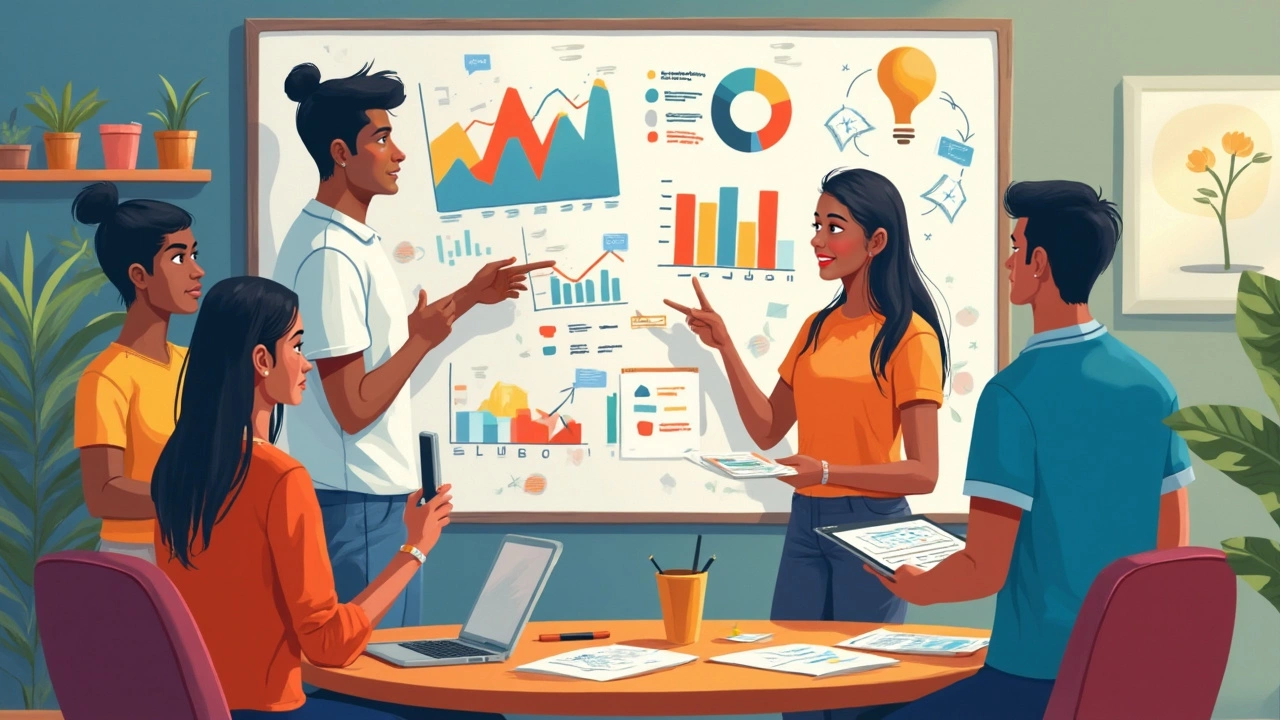How to Be a Digital Marketer with No Experience: Your Step-By-Step Game Plan
Everybody wants a cool digital marketing job, but most people get stuck on that one annoying question: how do you begin if you have zero experience? Good news—it’s not some secret club. You really don’t need a fancy degree or big-shot contacts. You just need grit, curiosity, and a way to show some real skills.
Start by focusing on what digital marketing actually means. It isn’t just running ad campaigns or making Instagram posts look nice. It’s about getting attention online, building trust, and nudging people to take action. Sounds simple, but landing that first opportunity? That’s where most get lost.
Here’s what gets overlooked: tons of free tools and short courses are out there, and they’re perfect for beginners. YouTube channels like Surfside PPC or Moz break things down without sounding like robots. Free Google certifications let you snag badges you can show off on your LinkedIn. If you’re serious, spending your next Saturday diving into these is way more valuable than scrolling TikTok.
- Understanding Digital Marketing Basics
- Zero to Hero: Free Tools and Resources
- Quick Skills You Can Start Using Now
- Building Your First Portfolio with No Clients
- Finding Real Opportunities (Even Without a Job)
- Mistakes to Dodge and How to Keep Growing
Understanding Digital Marketing Basics
If you’re just starting out in digital marketing, the landscape can look a bit overwhelming—but let’s break it down. Digital marketing covers everything a business does online to get noticed, win trust, and make sales. It doesn’t matter if it’s a pizza shop on Google Maps or Nike’s global video ads; the playbook has the same building blocks.
So, what actually counts as digital marketing? The main areas include:
- Search Engine Optimization (SEO): Making websites and content show up on Google when someone searches for stuff.
- Social Media Marketing: Posting, running ads, or even chatting with customers on platforms like Instagram and Facebook.
- Email Marketing: Sending helpful emails to bring people back or turn them into customers.
- PPC (Pay-Per-Click) Advertising: Running ads on search engines or social networks, and paying only when someone clicks.
- Content Marketing: Creating helpful blogs, videos, guides or posts that answer questions and solve problems.
Nearly every business—big or small—uses some or all of these. Here’s the kicker: As of early 2025, over 65% of all web traffic worldwide comes from mobile devices. So, all those digital marketing channels now have to work on phones first. That fact alone changes how you write, design, and reach people.
If you want to dip your toes in, don’t stress about mastering everything at once. Most pros started by picking one area—maybe creating simple Instagram graphics or helping a friend’s small business show up on Google Maps. If you get the basics of how and why these tools matter, you’ll quickly figure out which path feels right. Still, every marketer should at least be familiar with:
- What keywords are and why they matter
- How websites track visitors using Google Analytics
- The difference between organic (free) vs paid traffic (ads)
- What makes a good social media post vs a forgettable one
Here’s a quick cheat sheet on where different digital marketing channels stack up based on how businesses use them:
| Channel | Main Goal | Learning Curve |
|---|---|---|
| SEO | Organic website traffic over time | Medium |
| Social Media | Build community, brand visibility | Easy to Start |
| Email Marketing | Customer retention, repeat visits | Easy |
| PPC Ads | Immediate website visits or sales | Medium to Hard |
| Content (Blogs, Video) | Answer questions, build trust | Easy to Start |
The best thing you can do right now: Pick one channel, read two strong blog articles or watch a quality YouTube video on it, and jot down what you learn. No expensive tools, no pressure. But the more familiar you get with these basics, the easier everything else will snap into place.
Zero to Hero: Free Tools and Resources
If you’re thinking, “I can’t afford expensive software or courses,” relax. Most digital marketing pros started out using the same free tools that are out there for anyone. These aren’t lesser versions—they’re what the giants like Google and HubSpot offer to get you learning and using their stuff early on. Let’s run through what’s actually going to help you grow.
- Google Analytics: It’s the go-to for tracking website traffic and user behavior. Google’s own Analytics Academy has beginner lessons that take an afternoon to finish. This is a core skill for *anyone* in digital marketing.
- Google Digital Garage: They’ve got their "Fundamentals of Digital Marketing" course—26 modules, super practical, and at the end you get a certificate you can link to your resume and LinkedIn. Recruiters actually look for these badges.
- Canva: For making quick graphics, Canva’s free version is more than enough. Need a social post, a logo, or a blog image? Drag, drop, download—done. It even has templates specially for marketing.
- Mailchimp Free Plan: Want to see how email campaigns work without spending cash? Mailchimp’s free plan has you covered for up to 500 contacts. You get to learn how to build a list, make simple newsletters, and measure results.
- Hootsuite Free (with limited accounts): For scheduling and tracking your social posts. You can monitor how posts do without logging into five different apps every day. This lets you focus on learning what works on each platform.
- Ubersuggest: This keyword research tool lets you dig up hot topics, see what’s trending, and spy on competitors’ top-performing content—all for free. That’s big if you want to nail your SEO game without paying up front.
Dive into these tools and you’re building real, hands-on skills. For context, check out how free tools stack up compared to paid ones. Here’s a real-world snapshot from 2025:
| Tool | Free Plan? | What You Get (Free Tier) |
|---|---|---|
| Google Analytics | Yes | Full website tracking, unlimited data |
| Mailchimp | Yes | 500 contacts, one audience |
| Canva | Yes | Thousands of templates, basic editing |
| Hootsuite | Yes | Limited social accounts, 5 posts scheduled |
| Ubersuggest | Yes | 3 searches/day, keyword ideas |
Here’s the move: Pick one platform at a time and get your hands dirty. Don’t just watch tutorial videos; mess around, try things, fail a bit, then figure out what worked. Building confidence is about doing, not just learning.
Quick Skills You Can Start Using Now
If you want to get moving in digital marketing but have no experience, skip the theory and focus on real, practical skills. Employers love people who can jump in and actually do stuff, not just talk about it. So, what quick wins should you chase?
1. Google Analytics Basics
Learn how to set up Google Analytics, read simple dashboards, and spot which pages get the most traffic. Google offers a free beginner course called Google Analytics for Beginners. This single skill will instantly make you look less like a newbie.
2. Social Media Scheduling
Get comfy with free tools like Buffer or Hootsuite. Play around with scheduling posts, checking out post analytics, and trying out different styles of content. These platforms often come with short, snappy tutorials that get you started in under 20 minutes.
3. Email Campaign Tools
Mailchimp's free plan lets you create real campaigns and tracks open rates and clicks, letting you see how well your subject lines work. Most businesses start with tools like this, and you can practice by building a newsletter—even if it’s just for family, friends, or your own tiny project.
- Write a punchy email subject line
- Add a call-to-action button
- Segment a list into two small audiences and send a test email to both.
4. Simple SEO Tweaks
Grab the Yoast SEO plugin (it’s free if you have a WordPress blog) or use Google's PageSpeed Insights to spot easy website fixes. Learning how to make a site faster or tweak basic keywords matters a lot. Backlinko, for example, found that sites on the first page of Google search results all had noticeably faster load times than those lower down.
5. Canva Design Tricks
Canva is the beginner’s best friend for graphic design. No Photoshop skills needed. You can create Instagram graphics, simple flyers, or even infographics for LinkedIn posts. There’s a treasure trove of free templates—mess around with the features until you can whip something up in under 10 minutes.
| Skill | Tool | Avg. Time to Set Up |
|---|---|---|
| Google Analytics | Google Analytics Academy | 1 hour |
| Social Posts | Buffer | 20 min |
| Email Campaigns | Mailchimp | 30 min |
| SEO Basics | Yoast/PageSpeed Insights | 40 min |
| Easy Graphics | Canva | 15 min |
You don’t need months to start. Try each of these quick skills and you’ll have talking points for your first gig, or even something to show right away. That’s how you get noticed in digital marketing—by actually doing, not just learning about it.

Building Your First Portfolio with No Clients
This is where lots of people freeze up. How can you make a digital marketing portfolio if you don’t have clients blowing up your inbox? Here’s the truth: you don’t need paying clients to put real work in your portfolio. You just need proof that you can walk the walk.
Start simple. Pick a topic you like—a local coffee shop, a friend’s hobby podcast, even your favorite band. Pretend they are your client. Then go ahead and actually build what a client would need:
- Social media content calendars: Map out a month of posts with captions and images using a free tool like Canva. Actual marketers do this all the time.
- Email marketing drafts: Write three email blasts for your chosen business. Use Mailchimp’s free version to design them, or just make them in Google Docs and show screenshots.
- Google Ads samples: Use Google’s Keyword Planner (free!) to make a simple ad group. Screenshot your ad copy, keywords, and targeting ideas.
- SEO keyword plans: Run a quick analysis using Google Trends or the free SEMrush trial. List what keywords you’d target and how you’d use them in real blog posts.
Now pull these examples together into one simple PDF or a Google Drive folder and make it look clean. Use a free website builder like Wix or Carrd if you want a simple portfolio website. Show off your process and finished pieces. This isn’t just theory—it’s proof that you understand digital marketing and can create what clients actually need.
Some folks even go a step further by running micro-campaigns for $10 or less on their own Instagram or hobby blog. According to HubSpot’s 2024 survey, people who built samples based on personal brands tripled their chances of getting hired for entry-level digital marketing gigs.
Don’t fake anything. Nobody expects you to have huge results right away. What counts is showing that you can think, plan, and execute like a beginner digital marketer. That’s all it takes to catch that first real opportunity.
Finding Real Opportunities (Even Without a Job)
This part trips up a lot of beginners in digital marketing. Here’s the thing: you don’t need a job title to rack up real experience or results. There are plenty of ways to prove you know your stuff, even before anyone hires you.
The easiest move is to offer your services for free or a small fee to local small businesses, charities, or even family or friends who run their own thing. Most small businesses are glad for extra help getting noticed online. Ask if you can set up their Google Business Profile, create a few social media posts, or tidy up their website SEO. Document the results—take screenshots, gather stats, and show what changed because of your work.
Making your own project is another super-smart way in. Start a simple blog or Instagram account about something you actually care about (not just marketing for the sake of marketing). As you post and promote, track your traffic, follower growth, or engagement. These numbers are gold for your portfolio, and you actually learn by doing, not just watching others.
- Help a friend launch a promo for their home-baked cookies or handyman gig.
- Edit the social media bio for your local gym and measure engagement over one month.
- Test Google Ads for a fake company—Google’s Skillshop gives ad credits for learning.
Aside from hands-on work, enter online communities like r/digital_marketing or LinkedIn groups. Sometimes, actual business owners pop up looking for quick help. These mini-projects can snowball into more—plus, you pick up how to talk the talk with real clients.
If you want the fastest path to paid gigs, micro-task job boards like Upwork, PeoplePerHour, and Fiverr let you pitch for small digital marketing jobs. For example, as of this year, 41% of Upwork job listings are entry-level or "no experience required." These platforms may not pay huge at the start, but they help you lock down real reviews—and reviews matter more than a diploma for your first few clients.
| Platform | Type | Starter Advantage |
|---|---|---|
| Upwork | Freelance gigs | Entry-level jobs common |
| Networking, direct offers | Visibility with portfolio | |
| Fiverr | Micro-tasks, short projects | No experience barriers |
Remember, the goal is to rack up little wins and prove your work. Don’t wait—stack up hands-on, real-world results no matter how small the project looks. Clients and employers care way more about proof than about where you learned it.
Mistakes to Dodge and How to Keep Growing
When you’re fresh in digital marketing, you’ll run into common pitfalls that can trip up your momentum. A big one? Trying to learn every platform at once. You don’t need to master Google Ads, Facebook, SEO, digital marketing course materials, and content writing in the same week. Pick one or two, get comfortable, then expand.
Another classic mistake is treating online courses and certifications as magic tickets. They look nice, but hiring managers care more about what you can actually do. Don’t just collect certificates—apply what you learn right away. Build a project, start a blog, or help out a small business for free. Practice always beats theory in the real world.
Don’t ignore the data. Beginners often post content or run ads without checking what’s working. Use free analytics tools—like Google Analytics or Meta’s Ad Manager—from day one. Numbers show you if your plan works or needs a change.
Also, don’t go silent for months thinking you’ll pop back up once you’re an expert. Digital marketing changes fast. Algorithms shift, new tools appear, trends evolve. Even seasoned pros spend time every week keeping up with industry blogs or quick webinars.
- Focus on quality over quantity when building your first projects or portfolio pieces.
- Don’t copy others—original work stands out way more.
- Don’t be afraid to reach out to actual marketers on LinkedIn or through local meetups. A single real connection can unlock opportunities you’d never find scrolling job boards.
- Always ask for feedback. It stings to hear what you missed, but it’s the fastest way to level up.
If you want some perspective, check this out:
| Mistake | Why It Hurts | What To Do Instead |
|---|---|---|
| Learning too many tools at once | Burns out fast, nothing sticks | Master one platform, then branch out |
| Collecting certificates only | No real skill, just paper | Apply ASAP on real projects |
| Ignoring analytics | Can’t measure results | Dive into data early and often |
| Not networking | Miss hidden gigs/opportunities | Say hi to marketers, join groups |
Finally, never stop learning. Subscribe to a couple of sharp email newsletters, follow marketers who actually post practical advice, and carve out time for quick skill upgrades every month. That’s what keeps beginners moving forward instead of getting stuck at the starting line.





